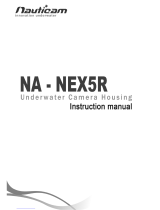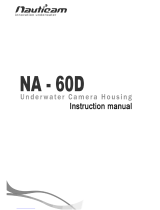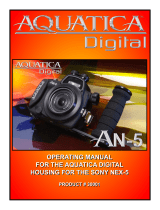Page is loading ...

Product Registration
Please register your product at ikelite.com within 15 days of purchase.
Our product registration database is the best way for us to contact you
in the event of a product update.
Underwater Housing for Panasonic Lumix
DMC-ZS40, TZ60, TZ61
Product Number 6170.40

2
About this Product
Thank you for your purchase of Ikelite equipment. Please read this
instruction manual completely before attempting to operate or dive
with this product. Please visit ikelite.com to register your product
to receive information on any updates or notices pertaining to your
equipment.
Included in the Box
• Housing
• O-ring # 0109 (installed)
• Port cover # 0200.08 (installed)
• Silicone lubricant

3
Important Notices
» To prevent salt build-up and sticking controls, submerge the
empty housing in clean, freshwater. Operate the controls
several times each while underwater to ush out any residue.
» Never leave a housing in a rinse tank, even if it is the only
system in the tank. Most catastrophic oods happen when the
user walks away from a housing while it is in the rinse tank.
» Do not use alcohol, cleaning agents, spray lubricants, Rain-X,
or other solvents on the housing or lens port. Use of an
incompatible chemical compound can damage the plastic and
o-rings, and may result in leaking.
» Always assemble in a cool, dry location. Opening the housing
in a humid environment will lead to fogging.

4
Contents
Product Registration 1
About this Product 2
Included in the Box 2
Important Notices 3
Getting to Know Your Housing 6
Setting Up Your Camera 8
Pre-Installation Checklist & Initial Camera Settings 8
Setting Up Your Housing 8
Opening the Housing 8
Closing the Housing 9
Final Check 10
Entering the Water 11
Zoom Control 11
Control Dial 12
Using the Built-in Flash 12
Using the Flash Diffuser 12
Installing the Flash Diffuser 12
Setting Up An External Strobe 13
Using the Flash Deector 13
Installing the Flash Deector 14
About Fiber Optic Cords 14
Attaching a Fiber Optic Cord 15
Maintaining Your Housing 16
Post-Dive 16
Lens Port 16
Storage 17
Servicing Recommendations 17
Lubricating Controls 17
Lubricating Push Buttons 18

5
Lubricating Control Shafts 19
Troubleshooting 21
Spare Parts 23
Limited Warranty 23
Service and Repairs 23
Contact Us 24

6
Getting to Know Your Housing
Tray mounts
Lens port
Fiber optic ports
Shutter
Control Ring
On/Off
Zoom
Lid snap
Mode dial

7
6170.40
DISP
WIFI
Fn
6170.40
DISP
WIFI
Fn
O-Ring
Lid Hook
Movie
picture
Control dial
Wi-Fi
Fn
Left / Macro
Down
Display
Playback
Up / Exposure
compensation
Right / Flash
Erase / Q.Menu
Menu / Set

8
Setting Up Your Camera
Pre-Installation Checklist & Initial Camera Settings
1. Set Flash Mode to “Forced Flash On” when connecting a ber optic
strobe.
2. Set Red-Eye Removal to “OFF.”
3. Set AF Assist Lamp to “OFF.”
4. Insert a fully charged camera battery.
5. Insert a properly formatted memory card.
Setting Up Your Housing
Opening the Housing
1. Push the lid snap lock forward and start to lift the curved end away
from the housing.
2. Lid snaps are designed to provide enough force to compress the
o-ring for a proper seal. Keep rm pressure against the lid snap
while lifting it away.
Lid Snap Lock
3. Repeat with remaining lid snaps.
4. Remove the housing back.

9
Closing the Housing
1. Remove any lanyard or neck strap which may be attached to the
camera.
2. Line the mounting screw up with the camera’s tripod socket. Use
a coin or at head screwdriver to tighten the mounting plate to the
camera.
3. Pull out on the housing control knobs to move them out of the way.
The motion picture control must be facing forward and upward to
allow clearance for proper camera installation.
4. Make sure the o-ring is clean and in its proper location on the back
of the housing. The main o-ring does not require lubricant to make
a seal.
5. Align the housing back with the front and carefully insert the camera
into the housing front until the rear o-ring is touching the front.
6. Make sure no controls or wires are interfering with the o-ring or the
back of the housing.
7. Place each lid snap into the corresponding hook on the housing
back.
8. Push the lid snaps towards the housing until they are at against
the housing and the lock has engaged. Close opposing lid snaps at
the same time.

10
9. Check the o-ring seal. The o-ring should form a uniform, solid line
around the back of the housing. There will be a small, even gap
around the housing between the housing back and the housing
front.
Even Gap on
All Sides
Housing Back
Main O-ring
Lid Snap
Lid Hook
Final Check
1. Re-check the o-ring seal. The seal should form an even, solid line
around the back of the housing.
2. Turn on the camera and check all control functions.
3. Make sure that the camera can obtain focus and take a photo.
4. Check battery life and open storage space on your memory card.
5. Check the ash, if using.
6. Submerge the housing in a fresh water tank dedicated to
underwater photography equipment. Visually conrm that there are
no signs of water intrusion or a steady stream of bubbles coming
from one of the housing seals.

11
Entering the Water
1. If possible, we recommend entering the water without your housing
to ensure that you are comfortable and your life-saving equipment
is in working order. Once you are stable, have someone pass your
camera housing to you.
2. Submerge the housing at the surface of the water and visually
conrm that there are no signs of water intrusion or a steady stream
of bubbles coming from one of the housing seals. If water does
appear to be entering the housing, point the lens port downward
and return the housing to the surface as quickly as possible. Always
observe all necessary safety precautions. NEVER ascend faster
than accepted safety limits.
3. Use your hand to gently ush away any small bubbles that may be
on the face of the lens port. Bubbles will produce soft focus spots in
your photo or video.
Zoom Control
After you have used the housing’s zoom control, it must be returned to
the center position to disengage. If the housing zoom control is
pushing the zoom lever in either direction, you may not be able to take
a picture or access other functions. This is because the camera is
receiving a signal from the engaged zoom control.
+
-
+
-

12
Control Dial
A small section of the rubber disc is missing at the end of this control.
This is normal and allows the user to completely disengage the control
from the camera when not in use.
To disengage the dial, line up the dot on the knob with the dot on the
housing back.
Using the Built-in Flash
The camera’s built-in ash may be used to illuminate subjects
underwater.
Using the Flash Diffuser
Install the semi-transparent diffuser when using the camera’s built-
in ash. A portion of the camera’s built-in ash may be blocked by
the housing’s lens port. The diffuser spreads the light of the ash to
reduce any effects on the image.
It may be necessary to zoom in when shooting close-up photos to
completely eliminate any darkened areas.
Installing the Flash Diffuser
1. The ash deector must be removed to use the camera’s built-
in ash to illuminate a photo. If a deector is installed, lift the
bottom with your thumb or a dull instrument and pull away from
the housing. The deector must be removed prior to inserting the
camera in the housing.
2. Press the large opening of the ash diffuser over the housing’s lens
port until it snaps into the groove in the outer circumference of the
port. The piece may bend during installation.

13
3. Orient the diffuser as shown.
4. Remove the diffuser by pulling it away from the port.
» A small hole in the corner of the ash diffuser allows it to be
attached to your system using a thin string (not included). It
is recommended to attach the ash diffuser to your system to
avoid accidental loss.
Setting Up An External Strobe
We recommend attaching an external strobe for the optimal color and
clarity in a wide variety of photographic situations, including daylight
photography.
This housing provides ber optic ports for optical triggering of up to
two strobes.
Using the Flash Deector
Install the opaque white ash deector when using external strobes.
The ash deector improves transmission of light to the ber optic
ports and reduces unwanted backscatter (the illumination of particles
in the water).

14
Installing the Flash Deector
1. Only the diffuser or deector should be installed at any given time.
If a diffuser is attached to the port, remove it by pulling it away from
the port. The ash deector must be installed prior to inserting the
camera in the housing.
2. Line the velcro dots on the deector with the velcro dots on the
inside of the housing’s front. When properly aligned, the holes in
the deector will line up with the ber optic ports on the housing.
3. Press the deector rmly into place.
4. To remove the deector, lift the bottom with your thumb or a dull
instrument and pull away from the housing.
About Fiber Optic Cords
Connecting a strobe via ber optic cord requires the camera’s built-in
ash to re for every photo. Rapid ring will be limited to the recycle
time of the camera’s built-in ash or the recycle time of the strobe,
whichever is slower.
The following ber optic cords are compatible with this housing:
• Ikelite Fiber Optic Cord # 4501
• INON Optical D Cable “Non-wireless type” L-Connector
• SEA&SEA Fiber Optic Cable (L-type) # 50107
Velcro Holes

15
• SEA&SEA Fiber Optic Cable II # 50128
• Olympus UW Fiber Optic Cable # PTCB-E02
• Nauticam Optical Fiber Cable # 26211 Nauticam to INON
• Nauticam Optical Fiber Cable # 26212 Nauticam to SEA&SEA
» To connect two strobes to the housing, you must use two ber
optic cords.
Attaching a Fiber Optic Cord
1. Check the end of the ber optic cord to ensure that it is clean and
smooth.
2. Check that the ber optic cord o-ring is in place. This o-ring does
not provide waterproong, but it does keep the ber optic cord in
place.
3. Attach one end of the ber optic cord to one of the ber optic ports
on the housing. The connector is a press-t into the port.
4. Attach the other end of the ber optic cord to a compatible strobe.
5. Set the strobe according to the manufacturer recommendations.
6. Turn on the strobe.
7. Turn on the camera. Take a test photo to ensure that your strobe(s)
are functioning properly.

16
Maintaining Your Housing
Post-Dive
1. Rinse the housing in fresh water. Rotate the housing controls and
press each button several times while submerged in fresh water to
ush out any salt or debris to ensure smooth operation on future
dives.
2. NEVER leave your housing in a fresh water rinse tank, even if it is
the only system in the tank. Collisions with another person’s gear
can cause scratches or damage to your equipment. Accidental
damage occurs most often in the rinse tank.
3. Rinse off any residual residue from the rinse tank with clean,
running fresh water.
4. Stow the housing in a shaded place where it is protected from
impact and overheating. If no shade is available, cover the housing
with a light colored towel or cloth.
5. Check the memory card capacity and battery life of your camera
and strobe(s). Recharge as necessary.
6. Always re-check the o-ring seal after opening the housing.
Lens Port
Treat the surface of the lens port like a camera lens. After use, rinse
and gently dry the outside lens port to avoid water spotting. Use only a
microber lens cleaning cloth to avoid scratches. To clean, use a mild
soap solution.
» Do not rinse the inside of the lens port.
» Do not use alcohol, cleaning agents, spray lubricants, Rain-X,
or other solvents on the housing or lens port. Use of an
incompatible chemical compound can damage the plastic and
o-rings, and may result in leaking.

17
Storage
1. Clean the housing and controls thoroughly prior to storage.
2. Remove the rear o-ring. Place in a small re-sealable plastic bag
inside of the housing.
3. Leave the lid snaps open to release pressure on the lid snap
springs.
4. Store the housing in a cool, dry place away from direct sunlight and
chemicals.
5. Before using the housing, check the tightness of the set screw in
each control knob. Check each control gland to make sure they are
snug. There is a slight chance that either could vibrate loose during
travel.
» Do not leave the camera and housing in direct sunlight for
prolonged periods. Heat may damage the camera.
» Do not transport with the camera inside of the housing.
» Do not store the housing in a humid environment. Prolonged
exposure to high humidity may damage electronic
components.
Servicing Recommendations
It is recommended that the housing be sent to Ikelite or an authorized
service center annually for routine service and maintenance. Service
may be required more or less frequently depending on care and use.
Lubricating Controls
The housing’s controls may need to be lubricated if they become
particularly difcult to use or if the o-rings have dried out during longer
periods of storage.

18
There will be some breaking force required to move the controls
initially after the housing has been in storage for long periods of time.
Remove controls for lubrication only if they continue to stick after
applying a small amount of lubricant to the exposed portion of the
shafts and working them many times.
» Use only Ikelite lubricant. Other types of lubricant may cause
swelling of o-rings or cracking of plastic components.
» Lubricant is not a sealant; it is used to reduce friction.
Excessive lubricant can collect sand, hair or debris which may
interfere with proper sealing.
» Never use spray lubricants as the propellant ingredient can
cause the plastic housing to crack or o-rings to swell.
Lubricating Push Buttons
1. Press and hold the push button all the way in.
2. Place a small amount of lubricant at the base of the push button
shaft inside the housing.
3. Press and release the push button several times to work the
lubricant into the o-ring.
4. If a push button control becomes difcult to push or if it sticks when
depressed, soak the housing in warm, soapy fresh water. After a
few minutes, operate the push button. If this does not correct the
problem, return the housing to Ikelite for maintenance.

19
» To prevent build-up of salt, sand, or debris, the push buttons
should be ushed with fresh, clean water after every use.
Depress each push button while the housing is submerged in
fresh water.
» If it is necessary to remove a housing push button, NEVER
re-use the e-clip. Push button o-ring kits include replacement
e-clips.
» Push buttons look similar but vary in length. Remove and re-
install one push button at a time.
Lubricating Control Shafts
1. Loosen the knob set screw using a hex key. Some set screws are
covered by a vinyl sleeve. The vinyl sleeve must be removed prior
to loosening the set screw.
2. Remove the control shaft from the inside of the housing.
3. Clean and lightly lubricate the shaft, including the large outer end of
the shaft.

20
4. If there is a spring associated with the control, make sure it is in its
proper position.
Control
gland
Control
shaft
Knob
set
screw
Housing
Control
at
5. Re-install the shaft from the inside of the housing. Rotate the shaft
gently for smooth installation into the gland. Push the control shaft
all of the way through until the at of the shaft is visible on the
outside of the housing.
6. Align the knob set screw with the control at.
7. Tighten the set screw rmly against the at of the control shaft using
a hex key.
8. Check that the set screw is oriented properly by holding the control
shaft in place on the inside of the housing while attempting to rotate
the control knob on the outside of the housing. If there is rotation,
loosen the set screw and realign with control at; retighten and
recheck.
» We do not recommend removing the control gland from the
housing.
» Always take the housing underwater to depth without a camera
after removing and re-installing controls.
» Remove and re-install one control at a time.
/









